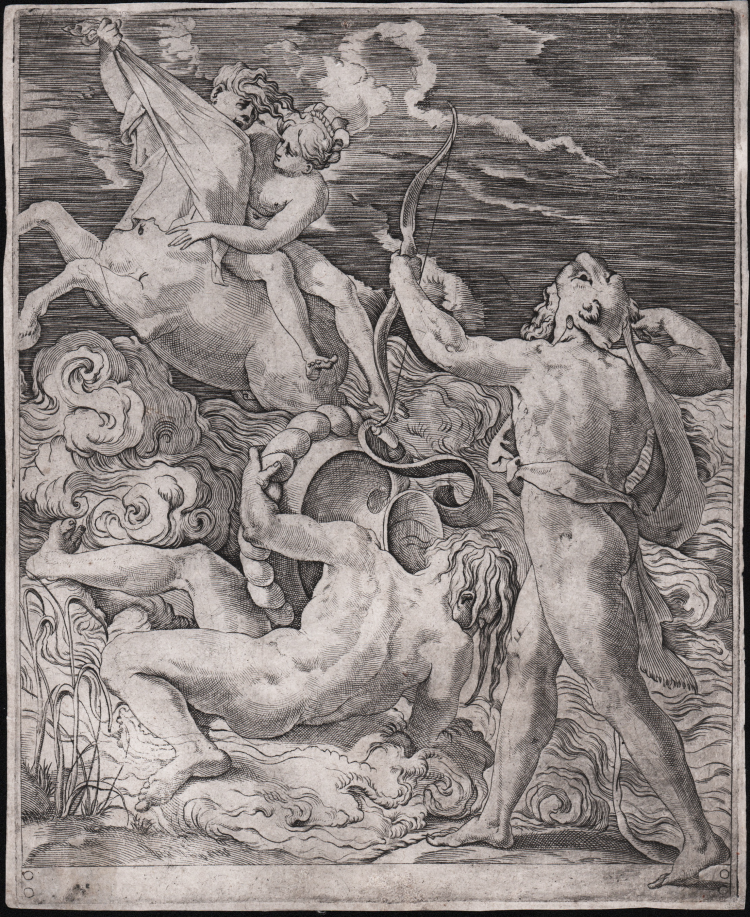




| Reference: | S42779 |
| Author | Gian Jacopo CARAGLIO |
| Year: | 1524 |
| Measures: | 178 x 220 mm |



| Reference: | S42779 |
| Author | Gian Jacopo CARAGLIO |
| Year: | 1524 |
| Measures: | 178 x 220 mm |
Engraving, 1524, without signature.
Hercules Fighting the Centaurs, from the series The Labors and Adventures of Hercules after Rosso Fiorentino.
Example of the first state of three.
A very good impression, printed on contemporary laid paper with “Tree in a shield” watermark (cf. Woodward nn. 131-134), thin margins, small repairs at the bottom, otherwise very good condition.
The series was made as one of Jacopo Caraglio's first collaborations with the publisher Baviera, and Vasari noted it followed upon the success of the Fury (Bartsch XV.92.58.). According to Carroll in Washington 1987, stylistically on Rosso's part and technically on Caraglio's, the series appears to be somewhat later than the Fury. Rosso Fiorentino's original designs, today lost, were probably influenced by Roman sarcophagi, as indicated by Cirillo Archer in TIB. Their manner resembles Roman works by Giulio Romano, Perino del Vaga and Polidoro da Caravaggio, but no actual relationship may be specified to their art. Strictly only two of the canonical twelve labors of Hercules are represented (Hercules Killing Cerberus and Hercules Killing the Hydra).
Bibliografia
Bartsch XV.86.47 (first state of two); Carrol, Washington 1987, n. 12; Cirillo Archer in TIB 1995, 2802.047.S1 (first state of three).
Gian Jacopo CARAGLIO (Verona 1505 - Cracovia 1565)
|
Giovanni Jacopo Caraglio or Caralio, Caral, Caralius, was a copper engraver, gem cutter, goldsmith and maybe even architect, according to Vasari. Caraglio was born approximately in 1505, in Verona or Parma, that is the reason why he often refers to himself as Veronensis or Parmensis. Because of the Sack of Rome he was obliged to leave unfinished his Ratto delle Sabine (The Rape of the Sabine Women), after a drawing of Rosso Fiorentino. He moved to Venice, were he worked until 1537.
While in Rome, he worked for Baviera, realizing in 1562 Dei dell’Olimpo, Fatiche di Ercole and Amori degli Dei, all after Rosso’s drawings, his favourite artist, together with Baldinelli and Parmigianino. While in Venice, on the contrary, he worked on subjects from Titian.
He moved to Poland in 1539 and started spreading the graphic art of Marcantonio in the Eastern Countries.
On July the 3rd, 1545, he joined the Court of Siegmund II, with an annual salary of 60 florins, till the death of the King in 1548; he afterwards worked for King Siegmund II Augustus as goldsmith and gem cutter. In 1552 he’s said to be working in Vilna, in Lithuania, the second capital city of the kingdom where the Court had temporarily moved. He went back and forth from Italy to Lithuania untill he died, on August the 26th, 1565.
Bartsch has listed 65 engravings belonging to Caraglio; Le Blanc has added other four subjects.
|
Gian Jacopo CARAGLIO (Verona 1505 - Cracovia 1565)
|
Giovanni Jacopo Caraglio or Caralio, Caral, Caralius, was a copper engraver, gem cutter, goldsmith and maybe even architect, according to Vasari. Caraglio was born approximately in 1505, in Verona or Parma, that is the reason why he often refers to himself as Veronensis or Parmensis. Because of the Sack of Rome he was obliged to leave unfinished his Ratto delle Sabine (The Rape of the Sabine Women), after a drawing of Rosso Fiorentino. He moved to Venice, were he worked until 1537.
While in Rome, he worked for Baviera, realizing in 1562 Dei dell’Olimpo, Fatiche di Ercole and Amori degli Dei, all after Rosso’s drawings, his favourite artist, together with Baldinelli and Parmigianino. While in Venice, on the contrary, he worked on subjects from Titian.
He moved to Poland in 1539 and started spreading the graphic art of Marcantonio in the Eastern Countries.
On July the 3rd, 1545, he joined the Court of Siegmund II, with an annual salary of 60 florins, till the death of the King in 1548; he afterwards worked for King Siegmund II Augustus as goldsmith and gem cutter. In 1552 he’s said to be working in Vilna, in Lithuania, the second capital city of the kingdom where the Court had temporarily moved. He went back and forth from Italy to Lithuania untill he died, on August the 26th, 1565.
Bartsch has listed 65 engravings belonging to Caraglio; Le Blanc has added other four subjects.
|